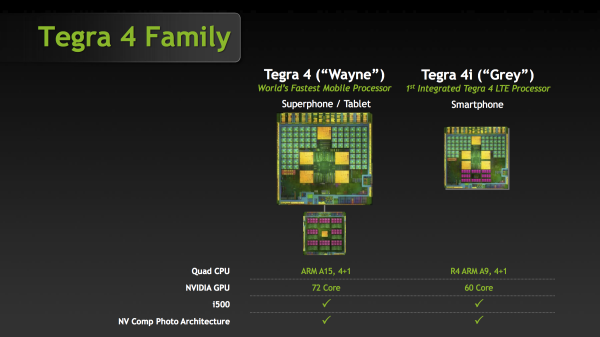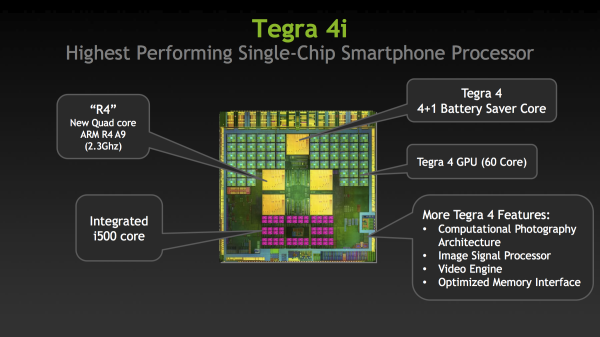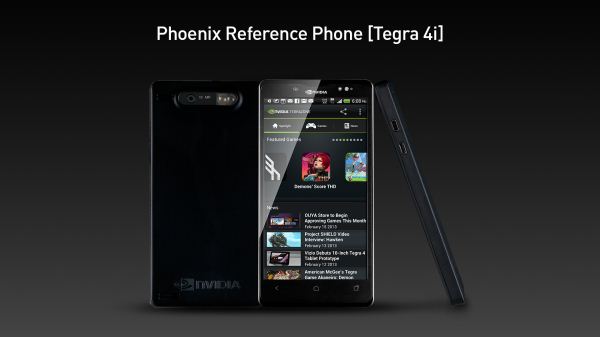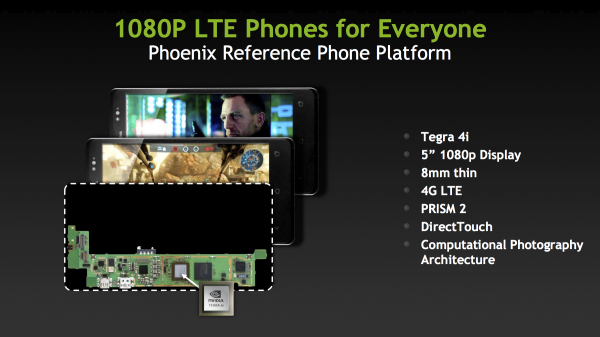NVIDIA Announces Tegra 4i, Formerly Project Grey, With Integrated LTE and Phoenix Reference Design
by Brian Klug & Anand Lal Shimpi on February 19, 2013 9:00 AM ESTIt has been a while since we’ve heard anything about Project Grey, the first NVIDIA SoC with an integrated digital baseband, and the result of NVIDIA’s acquisition of soft-modem manufacturer Icera. Today, NVIDIA is ready to formalize Project Grey as Tegra 4i, and we have a bunch of information about this SoC and will obtain even more before MWC is upon us. NVIDIA’s roadmap from late 2011 put Grey in early 2013, and while other members of that roadmap haven’t necessarily stuck to the promised release schedule, Grey seems to be somewhere close to that schedule, at least as far as announcement and samples are concerned.
First, Tegra 4i includes the familiar 4+1 arrangement of cores we've seen since Tegra 3, but instead of Tegra 4's A15s, 4i includes ARM Cortex A9 CPUs running at a maximum single core clock of 2.3 GHz, we’re still waiting on a breakdown of the clock rates for dual and quad configuration, as well as the shadow core. NVIDIA has noted that it using R4 of ARM’s Cortex A9, which includes higher IPC thanks to the addition of a better data prefetching engine, dedicated hardware for cache preload instructions and some larger buffers. NVIDIA believes it is the first to implement the latest version of ARM's Cortex A9 core, however there's nothing stopping others from doing the same.
NVIDIA likely chose to integrate ARM's Cortex A9 r4 instead of the Cortex A15 to reduce power consumption and die size. While Tegra 4 is expected to be around 80mm^2, Tegra 4i measures in at around 60mm^2 including integrated baseband. NVIDIA isn't talking about memory interfaces at this point, but do keep in mind that your memory interface is often defined by the size of your die.
The 4i SoC is also built on TSMC’s 28 HPM process, interestingly enough not the 28 HPL process used for Tegra 4. As Tegra 4i appears to be geared towards hitting very high clock speeds, the use of TSMC's 28nm HPM process makes sense.
Tegra 4i also gets the exact same ISP and computational photography features that Tegra 4 includes, along with the same video encode and decode blocks. When it comes to the GPU side, 4i includes 60 GPU cores, that's just shy of the 72 in Tegra 4 proper. We’re waiting on additional detail to understand if these cores include the same enhancements we saw in Tegra 4 vs. Tegra 3. We also don't know the clock speed of the GPU cores in Tegra 4i.
| Tegra 4 Comparison | |||||||
| Tegra 4 | Tegra 4i | ||||||
| CPU Configuration | 4+1 ARM Cortex A15 | 4+1 ARM Cortex A9 "r4" | |||||
| Single CPU Max Clock | 1.9 GHz | 2.3 GHz | |||||
| Process | 28nm HPL | 28nm HPM | |||||
| GPU Cores | 72 | 60 | |||||
| Memory Interface | PCDDR3 and LPDDR3 | LPDDR3 | |||||
| Display | 3200x2000 | 1920x1200 | |||||
| Baseband | No Integrated Modem |
Icera i500 |
|||||
| Package |
23x23 BGA 14x14 FCCSP |
12x12 POP 12x12 FCCSP |
|||||
Tegra 4i also includes the Icera i500 baseband IP block on-die, hence i for Icera. NVIDIA has disclosed some additional detail about i500 along the lines of what we’ve already written about. There’s full support for Category 3 (100 Mbps) LTE at launch, with a later upgrade to Category 4, along with support for 10 MHz + 10 MHz LTE carrier aggregation. In addition there’s support for the rest of the 3GPP suite of air interfaces, including WCDMA / HSPA+ up to 42 Mbps (Category 24), TD-SCDMA, and GSM/EDGE. i500 is also voice enabled with VoLTE support and CS-FB voice modes. NVIDIA claims that the i500 package is 7x7mm with a 6.5x6.5mm transceiver, and there are a total of 8 primary Rx ports (bands). NVIDIA also claims support for both 2x2 MIMO and 4x4 MIMO transmission modes on LTE.
Functionally Tegra 4i is more like a heavily upgraded Tegra 3 than a Tegra 4 part thanks to the Cortex A9s. It's clear that Tegra 4i is aimed more at the smartphone market while Tegra 4 proper aims at tablets or other platforms with a higher power budget and greater performance demands.
In terms of time frame, NVIDIA expects the first Tegra 4i designs to begin shipping at the end of 2013, with most devices appearing in Q1 of 2014. It'll be interesting to see how a Cortex A9 based design holds up in Q1 2014, although the newer core and very high clock speed should do a good job of keeping the SoC feeling more modern than you'd otherwise expect.
The other big announcement is a reference design built around Tegra 4i called Phoenix. It's a smartphone with Tegra 4i inside, 5-inch 1080p display, LTE, and just 8 mm of thickness. What's more impressive is that NVIDIA claims the reference design can be picked up by an OEM and ship with an unsubsidized price tag of between $100-$300 USD. With Phoenix NVIDIA now joins the likes of Qualcomm and Intel, both of whom already have active smartphone reference design programs.
We have a lot more questions about Tegra 4, 4i, and Phoenix, but answers are coming.














21 Comments
View All Comments
name99 - Tuesday, February 19, 2013 - link
His language is unpleasant, but he may not be wrong.The real issue is: what is nVidia trying to be?
There is one market (call it the Intel market) where you are shipping expensive, but clearly best of breed devices. There is another market (call it the VIA market) where you are selling devices that do work, and are really cheap. Both are viable businesses. But VIA doesn't pretend to be competing with Intel --- it doesn't market that way, it doesn't design that way, it doesn't price that way.
Then you have the third model (call it the AMD model) where you can't decide what you are. You market, design, and price (as much as you can) against Intel, but you can't deliver. THIS is not a good place to be. And it seems to be the place where nVidia is today.
sosadsohappy - Tuesday, February 19, 2013 - link
do not put in your blind fanboyism here. There is more to it than mere A9 vs A15 blah blah. You really want a 5hr talktime phone with A15? Well sure you can have it. Newer HTC phones are rumored to have 2300mAh with qualcomm's processor. Why? That architecture's perf is not even close to A15.http://blogs-images.forbes.com/jasonevangelho/file...
Quad-core A15 (T4) is mainly for tablets and high-end superphones. This T4i seems to be for general smartphone category. It has great perf/watt which is what matters for a smartphone. Performance-wise it will obviously not be as good as A15. But it is about what you want for a smartphone.
When someone comes out with A15 chip, certain people crib about battery power. When they come out with a low-power chip you crib about performance. Man, it is hard to satisfy one who wants it ALL in one chip.
lmcd - Tuesday, February 19, 2013 - link
Not really. Do you know what satisfied? The S4. Very few people disliked it. Hence the design wins.And now, the S4 Pro will be perfect for tablets.
sosadsohappy - Tuesday, February 19, 2013 - link
Thats the thing. All these processors are good enough for a smartphone. You cannot identify a .3millisecond lag while scrolling down a webpage.OTOH, users did not really have great options either to try out, as most of the phones were S4 due to LTE reasons (in USA). Design wins were due to LTE. The biggies like GS3, OneX did not have Snapdragon in them outside USA.
S4 is highly optimized for benchmarks. Even in that they fail against A15 miserably. Performance-wise A15 is much better than Krait. You have proofs online, if you want to search for. But well, a lot of them fall for marketing gimmicks such as benchmarks and are "satisfied", like you said.
FYI: perf of Krait is in between A9 and A15, more closer to A9. Perf of Apple A6 is in between A9 and A15, but more closer to A15.
Tegra4i is A9-R4. You can check the link in my previous comment. Its all facts and not philosophy. So Tegra4i could potentially have the perf of Krait (or better) but in a much smaller chip with lesser power. Sometimes people should put down their ego and just appreciate good engineering.
What we see here (tegra4i) is a phone chip. If you tend to disagree that this chip has good enough performance required for a smartphone, while is going to be a battery-saver, I don't know what else I can say.
tuxRoller - Tuesday, February 19, 2013 - link
Are we sure about that?With the higher ipc and clocks, we should be looking at around a 40% increase per core (that should put it close to an A15 running at 1.6). Their power draw might even be a bit lower than that of an A15 since the A15 seems about double that of the A9.
pugster - Thursday, February 21, 2013 - link
I don't think it is a desparate act. Right now it seems that only qualcomm is the only game in town when it comes to a single chip SOC solution and Nvidia is trying to crack into that market. The high end models would probably carry the Qualcomm chipset while the mid tier phones will carry the nvidia one.HisDivineOrder - Tuesday, February 19, 2013 - link
...to SOC's now. I mean, who'd want SOC's to be easy to read when they can make every part they design, regardless of which ARMv they are, the latest name, right?I'm sure the little "i" will catch EVERYONE's attention and make them realize it's a whole different generation of product.
derloos - Tuesday, February 19, 2013 - link
"...do keep in mind that your memory interface is often defined by the size of your die."I wonder what are the chances that 4i ends up with single-channel memory.
mayankleoboy1 - Tuesday, February 19, 2013 - link
100%, i'd say.derloos - Tuesday, February 19, 2013 - link
That'll make me a sad panda. Not that I love NVIDIA that much, quite the opposite...